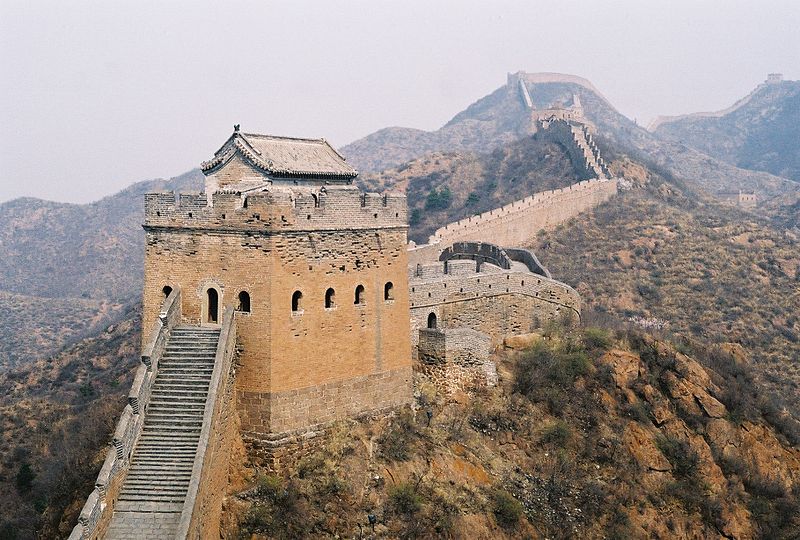(The anniversary of 9/11 brought about a flood of emotion. The media forced us to replay that day; it took me back to being 14 – a sophomore in high school – and the wild range of emotions this new, shocking event evoked. My 9/11 (2011) started with a little NPR that resulted in much soul-searching, and ultimately I resorted to driving in silence with my thoughts.)
Maybe we lack, as a nation, a certain type of vanity. The kind that would cause us to pause and consider what the rest of the world thinks of us. There are plenty of voices screaming, “who cares!?” And while that may not be the official line towed by our noble diplomats, it is the voice of our physical legacy in the places we have entered in the name of peace and stability.
 |
| Field of abandoned blast-walls - Iraq Courtesy: http://gocomics.typepad.com/the_sandbox/2008/08/graveyard-of-ol.html |
BLDGBLOG ran a timely post on 9/11(http://bldgblog.blogspot.com/2011/09/shape-of-war.html). Studio-X NYC hosted a discussion with photographer Simon Norfolk, focused on the spaces and technologies of post-9/11 warfare. While the discussion will surely explore the photographic qualities of such surreal places, and their modern implications, I would like to look at these new battlefields in the context of future diplomacy.
The physical works of militaries are some of the longest standing and most iconic on earth. We humans have a violent history; there is no doubt about that, and the infrastructure of conquest, control, and defense has long shaped our understanding of nations. The very need to build, the root of architecture, was to protect one’s self from the elements, the beasts, and inevitably, one’s neighbors.
 |
| Great wall of China. Thanks Wikipedia. |
Today we see the remains of warring, turbulent ages in the form of the majestic castles of Germany, France and England, the Great Wall of China, Hadrian’s Wall in Scotland, even the Acropolis in Athens. These iconic fortifications now help to form a national identity; they speak to a shared heritage and remain as symbols, sometimes painful ones, of pivotal points in a nation’s development. While these fortifications were useful in their own time, almost all were overrun by superior technologies or ceased fulfilling their intended purposed due to diplomatic resolutions.
 |
| Edinburgh Castle, Scotland. Thanks Wikipedia. |
Military infrastructure, like built work of any kind, is a cultural barometer. The materials used, the methods employed, all illuminate the greater political forces at work, and can even point to the source of conflict. The Castles and Fortresses of Medieval Europe, adorned with Christian imagery, speak not only to a time of adherent devotion to faith, but also to the wars being waged amongst Christian kings, each proclaiming divine right to rule.
Similarly, CHUs (containerized-housing-units), blast walls, fields of storage tanks, sallyports and bunkers all speak not only to the style of war being fought, but also to the resources and capabilities of the opposing forces. The physical presence of our military is indicative of a globalized force. Support systems are all containerized, ready for shipment to any corner of the globe. Bases are a package of components, each ready to plug-and-play in rapid deployment. And while these technological advances allow for the economical fabrication of miniature cities, they have come to demonstrate the kind of commercialization that has overrun our culture and permeated the military. In parts of the world where vast open land is part of tribal heritage and western notions of land owenership are foriegn, the imported 'Wal-Mart-esque' sprawl of bases and facilites convey a message of 'land-grabbing'. All of this is the result of a quick-fix mindset (the “surge” anyone?); whereas less economical solutions might prompt the more thoughtful allocation of resources, and greater emphasis on long-term strategic vision. Most importantly, we could leave a light footprint, and meaningful physical legacy; indicative of a country that respects the sovereignty of other nations and respects the future of its own image.
 |
| http://en.wikipedia.org/wiki/Hesco_bastion Thanks: US Navy |
The Romans built castras, the source of the word “castle”, many of which served not only as military outposts, but also as centers of trade, and provided the foundations of great cities around the Mediterranean and throughout Europe. Then again, maybe a comparison to the most notorious empire in history is not a good place to start a discussion on modern American diplomacy. The fact remains, the Roman Empire spread language, learning, governance, and commerce in a way never before witnessed. Starting to sound like familiar foreign policy? And the staying power of their outposts is evidenced by the great cities that sit atop their foundations today.
 |
| Roman "castra" - this one failed to become anything greater than a fort. A view into the future? http://en.wikipedia.org/wiki/Castra |
Regardless of our best diplomatic efforts, oratory and written resolutions have little staying power in the lives of those affected by conflicts. The places built, and things left behind will influence their collective feelings towards a foreign force that came in the name of peace and prosperity.
 |
| http://en.wikipedia.org/wiki/File:Camp_marmal02.JPG |
These ideas are too readily dismissed as phenomenology, when in fact there is an undeniable truth that the built environment speaks; and is much longer-winded than even the most verbose politician.
More on this to come…












